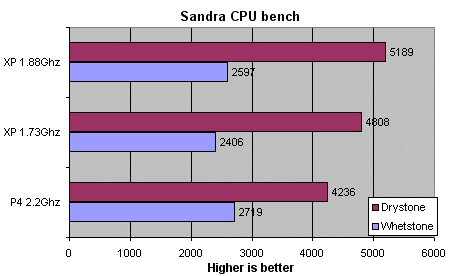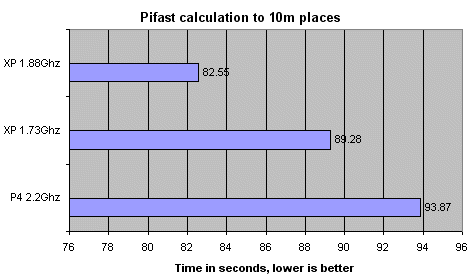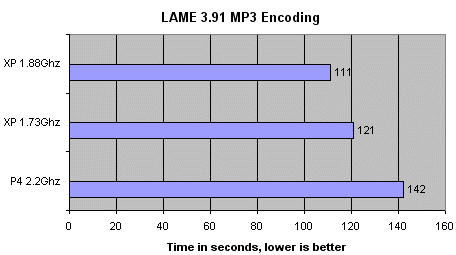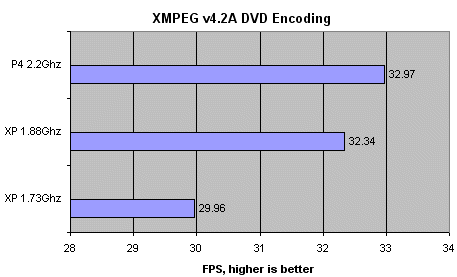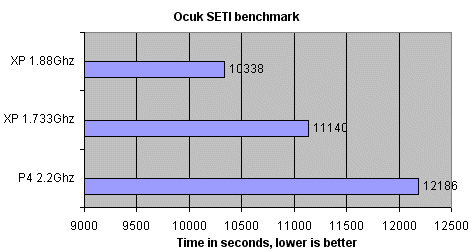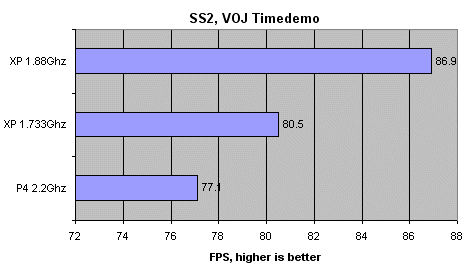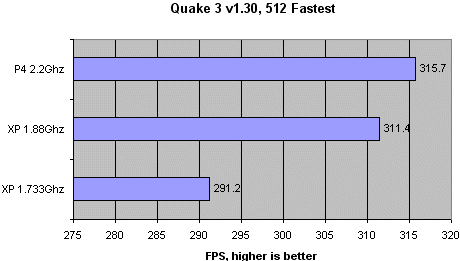AMD Athlon XP2100+
|
AMD Athlon XP
1733Mhz (XP2100+) Review In recent times, AMD's star has been on the rise. This rise in fortunes and public awareness has been fuelled by the excellent Athlon processor. Officially launched in August 1999 to critical acclaim, it finally gave AMD a performance edge over their main rival, Intel. This, coupled with a lower price-point, gave the enthusiast more performance for their pound. The Athlon originally debuted in Slot A format. AMD quickly moved to their present format, Socket A, the switch of formats was accompanied by a reduction in die size to 0.18u and a slight change in name. Athlons were now officially known as Thunderbirds. The Thunderbird differed from its predecessor by offering full-speed L2 cache, albeit reduced from 512kb to 256kb. They were able to out-pace the competing Pentium III's from Intel. The Thunderbird scaled reasonably well. In May 2001 we saw the release of the final Thunderbird clocked at 1400Mhz. At this time Intel had already successfully launched the Pentium IV line of processors, processors which scaled very easily due to their deep pipeline. October 2001 saw the retail release of the Athlon XP, essentially a Thunderbird core with a few important enhancements. The most important of these changes are detailed below.
These enhancements were grouped under the term 'quantispeed'. AMD also somewhat controversially decided to change the name designation from the industry-standard Mhz to their own XP rating. Their justification was that the new XP core, equipped with quantispeed benefits, could accomplish more work per given Mhz than it's predecessor, the Thunderbird. The XP debuted at a speed of XP1500 (1333Mhz). The 1500 rating referred to the probable clock-speed a Thunderbird would have to be clocked at to accomplish the same amount of work. Our tests at Hexus actually revealed that AMD had been somewhat conservative in their XP ratings, the core enhancements certainly boosted performance across the board. Others saw these XP ratings as AMD's desperate attempt to gain some sort of parity to the increased Pentium IV clock- speeds, which at this time had hit 2Ghz. We've previously demonstrated that an XP2000 (1666Mhz) can out-pace a 2Ghz Pentium IV in a variety of benchmarks and more than hold its own against the newly released Pentium IV 2.2Ghz NW. Therefore, in our eyes at least, the Quantispeed ratings are more than justified. Let's fast-forward to the present day, Intel have successfully launched their revamped range of Pentium IV processors, codenamed Northwood. The top-of-the-line 2.2Ghz NW pretty much matched the XP2000 blow-for-blow in our benchmarks. Today we see what AMD's newest CPU, the XP2100 (1733Mhz) can do. Although it's only a nominal 67Mhz faster than the XP2000, it furthers what is already an outstanding processor. Let's take a quick look at the specs of AMD's latest CPU.
Overclocking One of the attractions of the later Thunderbirds was the ability to manipulate speeds by either altering the FSB or the multiplier, they were factory unlocked. Even the earlier Thunderbirds / Durons were easy to modify to allow multiplier adjustment. Connecting the L1 bridges gave you full multiplier control. Unfortunately, the XP line of processors makes multiplier unlocking a more difficult task. Not only do you have to connect the L1 bridges, you also have to fill in the tiny crevice that exists between a pair of bridges. By no means impossible, it does make the job of unlocking an XP more difficult. For our overclocking efforts, we resorted to simply raising the FSB. We finally reached a rock-solid speed of 1880Mhz with 1.85v Vcore. Perhaps more pleasing was the fact that we could reach 1830Mhz with default voltage, suggesting that the XP still has a little headroom yet. System Setup Now let's see just how well the XP2100 performs. Here's a quick rundown of our test systems.
Common components
Software
All benchmarks were conducted at 1024x768x32 85Hz with vertical sync disabled. Benchmarks were run 3 times consecutively, an average score was taken. Both systems were configured for maximum performance. A fresh installation of Windows XP was used in both instances. We'll show the XP at stock speeds (1733Mhz) and stable overclocked speeds (1880Mhz), just so you can get an idea of what to expect. Remember, that we're running the Athlon XP on our new KT333 platform, one that allows asynchronous running of system memory. The Pentium 4 shall remain at stock speeds. Benchmarks from the Pentium 4 should only be compared directly with the stock XP2100. We'll leave the overclocked P4 competition to another day. Benchmarks We'll start with Sisoft Sandra. The synthetic CPU test has always favoured the Athlon XP, just as the memory test has been Intel and RAMBUS' domain. Let's see how the numbers stack up this time.
A mixed bag here, the Athlon wins the Drystone test comfortably but the P4 holds its own in the Whetstone test, ably aided by SSE2. However, when considered in isolation, nothing meaningful can be gleaned with these results. Historically, this benchmark has put the Athlon XP in a good light, our benchmarks reinforce this view. Let's move on to the memory tests. The quad-pumped P4, coupled with RAMBUS, albeit on a 100FSB, has always shined in this test, will we see anything unexpected ?
We see the superior memory throughput of the P4 lead the way here. Even the XP @ 1880Mhz (144.5 FSB) cannot quite live up to the blistering pace set by RAMBUS. RAMBUS is often slighted, however, it remains the fastest stock memory solution for either platform. Just imagine what a 133FSB RAMBUS solution running at full speed would do. We've recently included Pifast into our benchmarking suite. Pifast, although not a widely used application, needs both CPU speed and memory throughput. Our Sandra theoretical tests show the Athlon XP as having a clear lead in the CPU stakes whilst the P4 is the king of the memory game. The prodigious FPU of the Athlon XP should play a major part in this test.
We set our protagonists the task of calculating Pi (3.14159.....) to 10 million decimal places using the fastest method available. Although the graph seems to indicate otherwise, the results of the XP2100 and P4 2.2Ghz are within 6% of each other. The gap is consistent however. The aforementioned FPU of the Athlon XP truly goes to work here with impressive results. The slightly greater memory bandwidth of the P4 isn't quite able to compensate for the sheer, raw basic speed of the Athlon XP. We'll next turn our attention to another number-crunching activity. LAME MP3 encoding is popular with many of our readers. Here we use LAME 3.91 to encode a custom 481MB WAV file into a 128KB/s MP3.
Our preliminary tests revealed that LAME encoding is a purely cpu-intensive activity, certainly one that the Athlon XP favours. Our 481MB custom MP3 file was crunched in a little over 2 minutes by the stock XP2100, an additional 20 or so seconds were required for the P4 to complete the task. Whilst the difference isn't huge, it is significant. The extra muscle of the overclocked XP shaves another 10 or so seconds from stock performance. Extra performance for free is something we are very fond of at Hexus. The P4 has traditionally been touted as a media maestro, let's see if it can do any better in our DivX encoding test.
We're using Xmpeg 2.0, a derivative of the popular Flask encoder, coupled with the Div X 3.20 codec. We've found this combination to be the most stable in our stress tests. Three Kings is the DVD of choice, it's mixture of action and dialogue make it an excellent benchmarking test. The DVD is encoded in full-screen format into YUV2 format. The black borders are cropped to save unnecessary encoding time. The lo-motion codec is used with the bitrate set to 1500 KB/s. We calculate the average FPS after 20,000 frames have been encoded. We can clearly see that this is one field where the P4 excels in. It outshines the XP2100 by almost 3fps when compared at stock speeds. Even the overclocked XP at 1880Mhz isn't quite able to surpass the standard set by the P4. This is in stark contrast to LAME encoding where the XP outdistanced the P4 comfortably. As had been initially expected, we're seeing a mixed bag of results, each processor shining in certain aspects. Let's see if this trend continues. SETI is a pastime and activity that concerns many of our readers. SETI is a scientific experiment that uses Internet-connected computers in the Search for Extraterrestrial Intelligence by sifting through large amounts of data. Users download work units, complete them and send them back for verification. SETI is inherently a time consuming activity. Even today's machines take multiple hours in completing a work unit, so any time gained in the process would be greatly welcome. Let's see what the AMD's and Intel's best can do. We ran the Ocuk SETI benchmark, a rather tough work-unit with an angle ratio (AR) of 0.417. This one takes a while to complete. One advantage in this benchmark is it's ability to display results to within 1/1000th of a second, we've rounded the results up to the nearest second for the sake of brevity.
Another test where the impressive XP2100 puts over 15 minutes into the P4. So far we've been dealing with benchmarks that are differentiated by seconds, here we see multiple minutes, mainly due to the nature of the benchmark. The numbers quite clearly spell out that if SETI is your game, the XP will most likely be the best processor for your needs, especially if you like running processors at stock speeds. However, we've no doubt that an overclocked 2.2Ghz P4 would give the overclocked XP a run for its money. The times posted are still mighty impressive. Again, it seems the number crunching ability of the Athlon comes to the fore here. Let's move onto gaming, another facet of computing that challenges today's processors. The increasing complexity and geometry of modern games stresses even these top-end processors. We'll first turn our attention to 3DMark 2001SE. 3DMark, although a synthetic benchmark, is quite heavily reliant on pure CPU power / memory throughput. We've seen that it scales quite well when processor speeds are increased.
The potent combination of XP2100 coupled to a KT333 motherboard put daylight between themselves and the P4. The XP leads the P4 by 343 marks when considered on a stock basis. AMD's clock increase may only be a nominal 67Mhz over the XP200, but it simply helps the Athlon XP to extend its lead in this benchmark. Remember, we're using a stock Geforce 3 Ti500, so our results may differ from yours. As you can see, the overclocked XP crashes through the 9000 mark barrier with consummate ease. We await the arrival of the imminent P4 2.4Ghz to see if it can topple our resident champion from its perch. Serious Sam 2 has been grabbing our attention of late. Gorgeous visuals paired with frantic gameplay make it an exciting game to play. It also has an excellent built-in timedemo mode that makes benchmarking a pleasure. We've used the publicly available Serious Sam 2 demo for our test. We chose the Valley of the Jaguar timedemo as it's the one that stresses the CPU / memory subsystems the most. The massive geometry of the level requires huge CPU computations. You can access the timedemo mode by bringing down the console and typing /dem_bprofile=1. Simply run a demo and bring down the console (a la Quake 3 et al) to see your results. We've run the test at 1024x768x32 Normal settings, the massive geometry means that it's very CPU limited even at this playable resolution.
The graph is actually a shade misleading, the difference between our stock systems is 3fps. Although statistically significant, we'd challenge anyone to discern the difference between 77 and 80fps respectively. The enhanced Northwood core certainly makes some inroads into the Athlon's lead. The Willamette P4 used to lag behind rather badly in this test. The increased throughput of the overclocked XP sees it take a decisive lead in this benchmark. No CPU would be quite complete without visiting the venerable Quake 3. The Open GL benchmark of choice for the past 2 years. We'll have a look at 512 Fastest and 1024 Quality to see how the processors compare with one another.
The P4 has always ruled the roost when it comes to Q3, the gap closes quite dramatically with the more powerful XP2100, however, the P4 still reigns as the Q3 champion. Even the slowest of the bunch, 291fps from the XP2100, is mind-numbingly fast. The XP is no slouch in this test. Let's have a look at 1024 Quality, a resolution that should somewhat mirror real-life play.
The situation mirrors the fastest result, no surprise there. The gaps are understandably narrower due to the slight bottleneck created by the graphics card. We would hardly call 232fps slow. Naturally the test becomes card limited at 1600x1200
Conclusion Another release from AMD sees them, in our eyes at least, back at the top of the desktop CPU market. The XP2100 simply enhances what is already an excellent processor. We're pretty sure that the XP2100 will be the last 0.18u CPU from AMD, shortly to be replaced by the 0.13 Throughbred CPU. The nominal 67Mhz rise will come at a cost, however. We've been quoted prices in excess of £250 for the 1.733Ghz model, a price that will deter many people from the upgrade. The imminent arrival of the Thoroughbred also detracts from the attractiveness of the XP2100. Still, we can't help but be impressed with the performance of the XP2100, it took everything we threw at it and then some. The fact that our sample could hit 1800Mhz+ at default voltage shows that there is perhaps some headroom still available with the 0.18u manufacturing process. This bodes well for the short-term future for AMD as the reduction to 0.13u should see the XP scale to well beyond 2Ghz. The Pentium 4, although beaten in the majority of tests we conducted, is far from realising its true potential. The 2.4Ghz part is just around the corner and the move to 533FSB seems to be inevitable. The Athlon XP2100+ has shown that it still has enough to hold off Intel's challenge for the time being. Having said that, we cannot recommend this processor to anyone but die-hard enthusiasts. AMD's own Thoroughbred simply makes the XP2100+ a temporary stop-gap between the transition from 0.18 to 0.13 manufacturing processes respectively. Interesting times lie ahead of us in the desktop CPU market. We await to see what the future brings with increased optimism and anticipation. |






